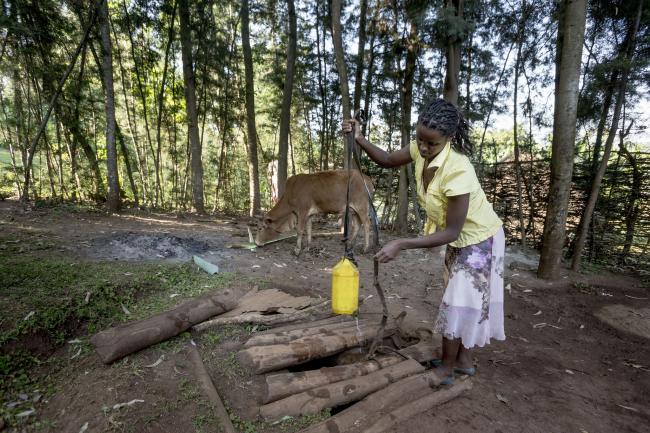Will Ethiopia's big economic push raise the country out of poverty? And will everyone in the country have water, sanitation and hygiene services in the coming years?
Published on: 29/01/2016

With high economic growth over the past decade, Sub-Saharan Africa's second-most populous country (96.5 million people) is heading to become a middle income country by 2025, according to the Ethiopia Economic Update of the World Bank. Will this growth boost Ethiopia's water, sanitation and hygiene services too?
Landlocked in the horn of Africa and as one of the world's oldest civilizations, Ethiopia was also one of the world's poorest countries until recently. However, the country is experiencing unprecedented economic growth and the government is implementing new policies to boost it further. Ethiopia aspires to reach middle income status over the next decade, and it might work.
The introduction of the first Growth and Transformation Plan in 2010 has stimulated economic growth and led to poverty reduction in urban and rural areas. As a non-oil economy, Ethiopia's government started investing and building its nation, spending both domestic and foreign resources to create a public sector which in the long run could boost the private sector.
"The main challenge that remains now, is to keep this progress going"
At a recent press conference, State Minister of Finance and Economic Cooperation Dr. Tekeste Abraham stated that "public investment is critical for Ethiopia and other developing countries because it helps enhance infrastructure development, capacity building as well as skill and knowledge expansion." Ethiopia's public investment rate is the third highest in the world now, and this 'big push' by the government aims at further boosting public investment-led development.
The country reached some Millennium Development Goals: primary school enrollments quadrupled, child mortality was cut in half, and the number of people with access to clean water more than doubled (see World Bank). With the second Growth and Transformation Plan that runs from 2016-2020, Ethiopia is strategically planning to meet the Sustainable Development Goals.
Bethel Terefe works in Addis Ababa as IRC Ethiopia Country Coordinator. IRC together with other partners from the water, sanitation and hygiene (WASH) sector is supporting the implementation of Ethiopia's second Growth and Transformation Plan.
"The main challenge that remains now, is to keep this progress going. The government is dedicating a very high share of its budget to pro-poor programs and investments. Improving water and sanitation is one of the pro-poor sectors getting strong government attention," she says. There might be some gaps. While government has placed health extension workers across the country some have raised concerns about the lack of clear budget lines for sanitation and uncertainty on the adequacy of investment. Recently, others such as Oxford University have raised concerns that poor rainfall might undermine growth after a series of good years. But overall the country is feeling rather positive.
"The focus of the second Growth and Transformation Plan is similar to sustainable development targets for WASH. We are working to improve service levels of water in both urban and rural areas." IRC contributes in a number of ways to these goals. "Under a DFID/UNICEF funded project focusing on improving WASH in 8 small towns, IRC supports the knowledge management aspect of the project, supporting research, learning and uptake about innovative approaches to improve WASH in urban areas."
Another one of IRC's main efforts is the support scaling up of Self-supply in Ethiopia together with other partners and with the funding of the Millennium Water Alliance.
Ethiopia has relatively recently recognized Self-supply as one of four rural water service delivery models in its national policy, and IRC supports the scaling up of Self-supply nationally through organizing learning events, providing technical support to development of guidelines and manuals, and training of government and NGO staff .
Self-supply means that households make their own investments in new and improved water supply facilities. Commonly, Self-supply involves digging traditional hand-dug wells to access shallow groundwater, but it may also means harvesting rainwater, treating the water at home, and storing it well to improve water quality. To trigger households to start doing this, loans are important. In the second Growth and Transformation Plan self-supply does not get much mention, and the plan aims at improving service levels, ease of access to enable multiple use, reduced distance traveled and more water per person. Self-supply can help to meet these objectives, especially for the hard to reach, and last to be served scattered rural households.
Bethel Terefe: "IRC with partners is conducting research on the current status of self-supply in 6 woredas. We are using the information to support Woreda governments - the smallest unit of local government in Ethiopia - to plan how to integrate self-supply in their activities.
Improved access to water through Self-supply can also help households to generate money and lift them out of poverty, as witnessed in some parts of the country. "To help people move to self-supply, it's important to create an enabling environment. For example, households need loans to construct self-supply facilities; the private sector should provide services; and products should be available."
This investment by people for their own family development mirrors what the government is doing at national scale. Investing to make things better. Bethel hopes that Ethiopia will "continue to go up this road of progress and achieve full coverage in 5 years, as well as substantially improving the quality of current water, sanitation and hygiene services."